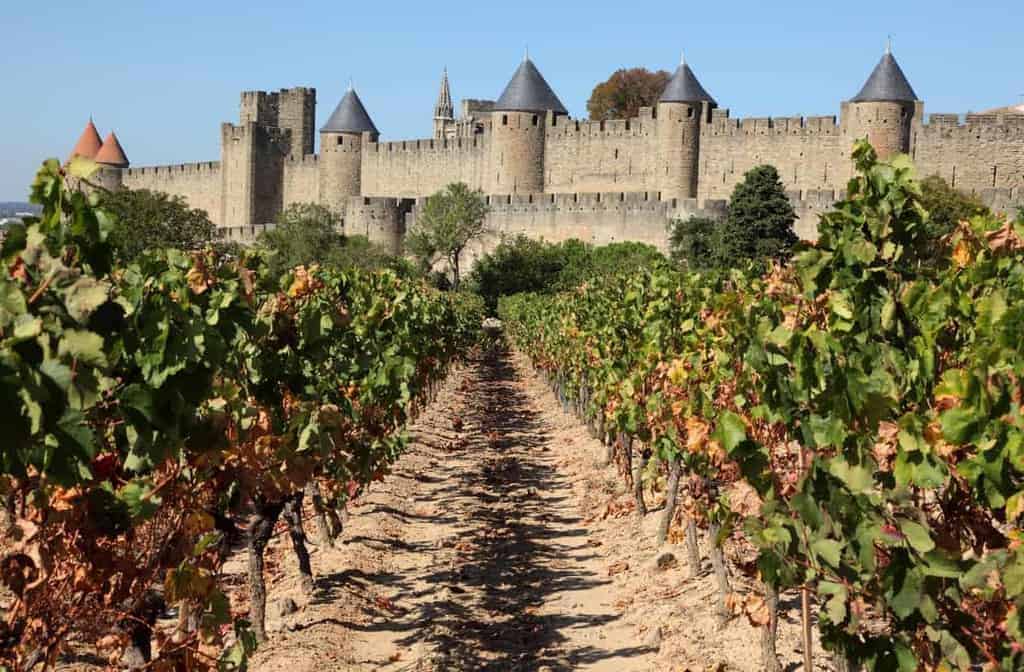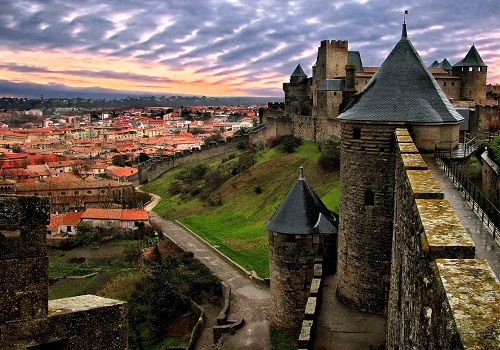Winetraveler is back in Languedoc, France for the final itinerary in this series which began with the northern wine routes of Languedoc from Montpellier to Pézanas. We then explored a more coastal itinerary encompassing Narbonne and AOP La Clape. This #Winetraveler travel guide now takes you down a more historic path to the Languedoc cities of Carcassonne and Limoux, so let’s get started!
How to Get to Coastal Languedoc
If you’re driving the entire Languedoc route we’ve laid out, you’ll simply drive west from the coast to the city of Carcassonne. However, if you’re beginning with this itinerary and flying in from the States, there are numerous flights to Paris daily and from there, it’s a quick flight to either Narbonne, Toulouse or Carcassonne. From these, we recommend hiring a driver to Carcassonne and for various excursions. Trains are also available from Paris direct to Carcassonne as well.
When to Visit
While we didn’t make a recommendation on trip timing with the other Languedoc itineraries, if you’re planning to visit Carcassonne, we personally prefer the off-season when crowds are significantly less than in the summer months. A fortress city, Carcassonne is a top tourist destination in France, drawing millions each year that fill the city from wall-to-wall in the summer months.
In the winter months, some attractions will be closed or have limited hours, so do your research in advance. However, spring and autumn are delightful with mostly sunny, temperate days.
Destination: Carcassonne
While it would be easy to lose oneself for weeks wandering this ancient region, Carcassonne and Limoux can also be part of a larger itinerary and done in as little as two nights. The recommendations to follow are what we suggest as the must-dos and sees no matter your length of stay.
Winetraveler Tip: Carcassonne is an easy destination for a family trip offering activities and history for all ages.
Where to Stay – Carcassonne, France
Hotel Mercure Carcassonne la Cité
Outside of the city walls, the Hotel Mercure offers views of the castle, a secure car park and sits within easy walking distance of the old city. An onsite restaurant and bar are convenient options for breakfast and nightcaps.
For more of a splurge, treat yourself to a stay at the 5-star Hotel de la Cité within the fortress walls. Built in the 19th century, the hotel offers an outdoor pool, shaded park and a gourmet restaurant called the Barbacane.
Things To Do in Carcassonne
La Cité Médiévale
First and foremost, see a sunrise and sunset with La Cité as a backdrop. Then, wander the cobblestone-lined winding corridors as the sun rises or sets to see the dramatic changing shadows and light cast by the many sconces, archways and towers. It’s simply magical!
La Cité is the double-walled fortress surrounding the old town with 52 watchtowers built more than two centuries ago. An entrance fee must be paid to walk along the walls at the Château et Remparts, a keep built for the viscounts of Carcassonne during the 12th century. The Remparts ticket includes access to the keep’s rooms and the battlements with dramatic views of the region and the Pyrenees.
Located at the highest point of La Cité where the earliest known settlement of the region in the 6th century BC is said to have stood, is the 12th-century castle, Château Comtal. The hilltop castle overlooks the valley of the Aude and what would have been the ancient routes linking the Atlantic, Mediterranean and the Iberian Peninsula with the rest of Europe. The castle is only available by paid entry, which can be combined with the Remparts, and offers a museum, displays of medieval military art as well as other historical showcases.
In between the double walls of La Cité runs a flat interior space known as Les Lices. Originally designed as a defense, today it makes for a nice stroll around the city and it’s particularly private at day-break.
Chapelle Notre Dame de la Santé and Pont-Vieux
Spanning the Aude River is the pedestrian-only Pont-Vieux bridge. One of the oldest in the city. Built during the 14th century to connect Carcassonne’s lower and upper towns, it was rebuilt in the 19th century and remains one of the few medieval bridges in France. Nearby the Pont-Vieux is the Chapelle Notre Dame de la Santé, which was built in 1523 with a portion of the building serving as the city’s first hospital.
Where to Eat in Carcassonne
Visitors to Carcassonne can hardly go hungry with a plethora of restaurants, cafes and eateries. That being said we have a few favorites. For the carnivorous crowd, the region’s renowned cassoulet is necessary – just don’t plan anything other than a good night’s rest or nap afterwards.
A traditional local market in Carcassonne dating back to 1768, Les Halles is the perfect place to stop and explore the local wines, foods and cheeses of the area as well as marvel at the beautiful stone architecture.
Eat here. Order the cassoulet. Period.
Restaurant Gastronomique La Barbacane
If you’re looking for lighter, but no less flavorful cuisine, Chef Jérôme Ryon showcases fish and vegetables from the Mediterranean region, as well as products from near his roots in Lyon. At La Barbacane, he creates traditional cuisine with elegance and finesse. The one Michelin star restaurant also offers terrace seating with views of La Cité’s walls.
Wineries to Visit Near Carcassonne
Being Winetravelers, a trip to the region would not be complete without stopping at a few wineries and one of the most significant Abbey’s in the wine world.
Are you a fan of sparkling wine? Well, it’s said to have gotten its start in this very Abbey in 1544 when a group of monks accidentally discovered the sparkling wine process largely by accident. After laying down the wines in the Abbey’s caves to rest for the winter, they discovered the wines had developed an effervescence characteristic of sparkling wines. Today tours of the historic Abbey and the original caves are available where a rich history and a crossroad of times, both of prayer and politics, are revealed.
Speaking of bubbly, Limoux is known for its traditional and ancestral method sparkling wines and Antech Limoux has been producing AOP sparkling wines in Limoux for six generations. Here the only varieties of grapes used are the regional Mauzac and the international Chenin, Chardonnay and Pinot Noir. Traditional method wines are aged anywhere from 18 months to five years on the lees. The winery also produces the traditional Blanquette de Limoux and a 100-percent Mauzac method ancestral. Today the winery is a member of La Route des Vinifilles and led by Françoise Antech. A tasting room and shop are open to the public and a must-visit while in Carcassonne.
Winetraveler Tip: Try the Grande Cuvée Brut 2013 – a traditional method sparkling wine aged five years on the lees and one-year in the bottle with four grams of dosage.
In the heart of the Cabardès appellation sits the vineyards of Maison Ventenac, where the oceanic and Mediterranean winds meet. AOP Cabardès is the only appellation in Languedoc with the obligation to assemble wines with a minimum of 40% of Atlantic varieties, Cabernet Sauvignon or Merlot, and 40% of Mediterranean varieties, Syrah and Grenache. You’ll find some of these typical blends at Maison Ventenac, but also a line of single varietal wines showcasing the freshness of the grape as grown in this AOP. In fact, tuns, wooden casks, terra cotta urns, or concrete often replace barrels to fully display the grape and terroir.
To visit, appointments are requested in advance and tastings will often occur in the cellar with wines poured directly from the tanks or casks. We highly recommend checking out or purchasing wines from the single varietal line, Les Dissidents. Simply superb.
Plan Your Getaway
While these three itineraries only scape the surface of what the Languedoc has to offer, we hope to have provided a solid starting point from which to explore this sun-soaked wine region where the wines far surpass their value and the culture welcomes with warmth and conviviality. Have additional questions or need more recommendations? Feel free to reach out in the comment section below.


